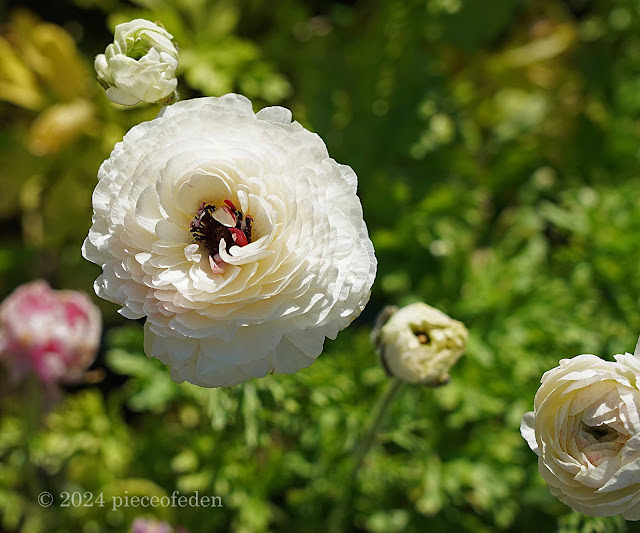Flower as crop: these are past saleability
Irrigation is via an elaborate drip system that can be moved or adjusting in multiple ways according to the crop and season:
Scabiosa flowers are one of the flowers grown.
Crops are rotated throughout the growing field for soil health.
Lisianthus plugs had just gone in. This is one of the only crops not grown from seed. Lisianthus takes a long time to grow so the farm uses plugs. These plants will be producing heavily in August into September.
The major pest at this farm is, surprisingly, Crows. They find small seedlings delicious and can quickly yank and eat an entire crop. The farmer protects tender young seedlings via screening, wire, and row-covers.
And uses mini pompoms as scare-crows:
The attention to timing is constant. Florists need a steady, reliable supply of flowers. The farmer covers and uncovers shade cloth constantly according to the weather to either slow down or speed up production. Seeds are planted successively, week by week, for two crops a year: spring into summer, and fall into winter
An old outbuilding acts as a potting bench for seed starting among other tasks.
Don't we gardeners all wish we had something like this?
While Sweet Peas are poor cut flowers, lasting only a couple of days, their charm and fragrance makes them irresistible. The farmer grows them for a "Cut Your Own" event for families.
California had a thriving florist flower industry throughout the 20th century. During the Bush administration, in order to try to reduce the flow of narcotics from South America, cut flower import fees, tariffs, and regulations were slashed to encourage cut flower farming instead of coca farming. This hastened the end of florist flower growing in California.
In the past few years with the farm-to-table movement and the environmental cost of air shipping, forest clearing, and pesticide use, a new "farm-to-vase" industry has appeared. This farm is part of that.
Here's the surprise: this farm operates successfully on a family's 3/4 acre property that also is their home.
Flowers the farm produces include: Sunflowers, Dahlias, Larkspur, Bells of Ireland, Stock, Celosia, Cosmos, Zinnias, Strawflowers, Nigella, and Scabiosa.
It was a wonderful and educational event. Many thanks to the family for hosting our club. The farm's website is here and they are also on Facebook and Instagram.

















Wow, that IS really elaborate! But the crops look healthy and beautiful!
ReplyDeleteIt was really really cool to see someone doing what she is doing and with flowers.
DeleteWhat a neat trip! I'm glad you were able to join in with your Beloved's help. It's interesting to hear about the historical fluctuations in the floral industry in California, as well as the challenges of making a business out of it now.
ReplyDeleteThe "green" industry which includes the floral industry is quite fascinating.
DeleteA family flower farm: so lovely and I'm certain a lot of work. Their website offers to host 'wild flower arrangements' parties. What a fantastic idea for a group of friends.
ReplyDeleteThe wine-red Scabiosa has a new-to-me color. Gorgeous.
Chavli
Yes that Scabiosa was swoony-good! Farming means doing all sorts of slightly different things to make a living. True for flower-farming as well as the food kind.
DeleteI'm really impressed with this family farm, what a great visit. And a definite Yes, please on the outbuilding.
ReplyDeleteYes yes that outbuilding. Sigh!
DeleteFun outing. It's a lot of work being a flower farmer but also very rewarding when every ogles your gorgeous creations. I used to do cutflower arrangements for when I sold organic produce at our local farmer's market. The flowers were the big draw selling first but people would pick up veggies too. Apparently veggies are sexy enough on their own. Who knew!
ReplyDeleteWe gardeners knew! :^)
DeleteThis post gives me a hope that cut-flower farms may survive in California. But what a lot of work and dedication it takes!
ReplyDeleteThe farmer said following a schedule, constant sowing of seeds for staggered production, and constantly adjusting shade cloth and watering in response to variations in the weather. It's farming, not gardening. But still playing in the dirt with plants! :)
DeleteI had no idea how much planting had to occur to keep a cut flower business going. That is a tremendous amount of work. Your garden group is pretty large!
ReplyDelete